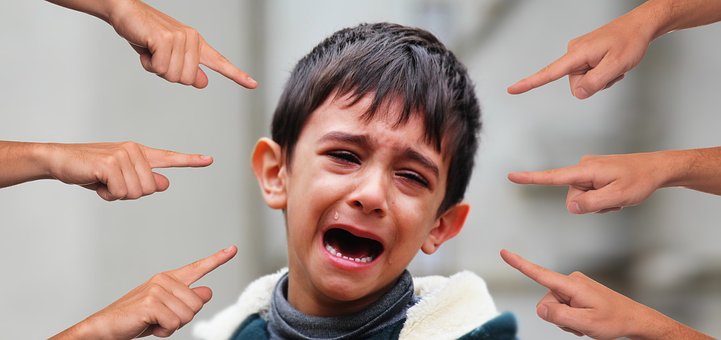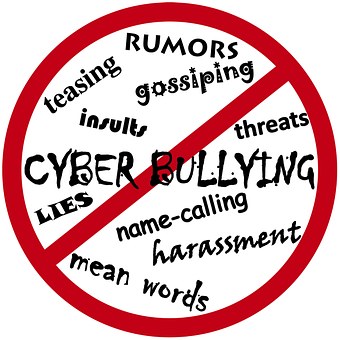
Little Rohan came home crying because someone in the swimming pool locker room had broken his glasses into pieces and thrown it away.
Aman came out of the pool and when he went to change, his clothes were missing from the locker. They were found in the toilet.
Instances such as these are alarming and on the rise in schools and play areas. They leave the parents anxious and worried all the time. Can parents be around all the time guarding their little ones against lurking bullies? Somewhere one has to let go and trust that their child is able to handle the bully on his own.
According to a survey conducted in 2013, in 150 schools in Mumbai and Thane by the Parents Teachers Association United Forum (PTAUF), 70 percent of students experience bullying in school, but only 20 to 40 per cent report it. Seventy percent even admitted to bullying being their pastime.*
What is Bullying
According to Cambridge dictionary “to hurt or frighten someone, often over a period of time, and often forcing that person to do something they do not want to do”
Types of Bullying
- Direct: This can be physical like pushing, hitting, kicking or taking away things. Verbal like name calling, threatening, psychological intimidation.
- Indirect: Gossiping, sabotaging, excluding from groups and convincing others to do the same.
- Cyber Bullying: Threatening, harassing, intimidating using electronic medium
Bullying consists of three main participants:
1. Raja is youngest in a family of six and throws tantrums if his needs are not met. He has a short attention span and gets angry and irritated easily. His mother loses her temper easily and whenever there is a conflict with the adult members at home, she takes it out on Raja more than his brother. Raja’s parents are busy and don’t have much time for the children. What more they complain to everyone about their children. Presence of grandparents doesn’t help the cause as they also complain to the parents about Raja’s behavior. Raja likes to torment his classmates and younger children whenever he finds an opportunity. He verbally abuses them and sometimes snatches their lunch and eats it.
Raja is a Bully
2. Ankur was a premature baby and was prone to frequent colds. He is small for his age and very sensitive. He is soft spoken and shy and doesn’t make too many friends. He tends to internalize everything and gets upset easily. His mother is over protective of him and his father believes that this molly coddling is only making him weak and wants to toughen him up. Nothing he does seem to please his father. In school, he is run over by everyone practically, but Ankur doesn’t complain for the fear of antagonizing his tormentors.
Ankur is a victim
3. Sahil is one of many children in his extended family. His older cousins have always teased him and made him do errands. If he goes complaining to his mother, they threaten to never ever include him in their activities. Sometimes he even gets pushed around or hit by his elder brother who is a part of the “grown up gang”. Sahil resents all this and takes out his frustration on his classmates in the school. His teacher keeps complaining to his parents which in turn triggers another round of humiliation in front of his older brother and cousins at home.
Sahil is a bully victim
Dr Arundhati Chavan, professor at SNDT College and president of PTAUF who led the survey, says, “Bullying leaves a lasting mark. Victims may shy away from the crowd and develop an inferiority complex. Repeated bullying may also make them aggressive and prone to lashing out.”**

What makes a bully?
- Emotional/developmental/behavioral problems
- Low academic achievement
- Negative peer influence
- Unsafe neighborhood
- Lack of parental monitoring
- Corporal punishments by parents, excessive criticism or control
- Substance use
- High levels of anger in the child

Who is the potential victim for bullying
- Being physically weaker
- Poor social skills
- Low self-esteem
- Prone to low moods/depression
- Maternal over-protectiveness
- Intrusive or coercive parenting
- Child abuse
How do I find out if my child is a ‘Bully’
Parents would like to believe that their child can never be a bully. This kind of ostrich behavior only aggravates the situation. It’s important to interact with your children and find out more about their life outside home. If there are indications in your child’s behavior that make you uncomfortable like being defiant, bossing over younger sibling or temper tantrums it’s better to ask the following questions. Not all boys are bullies, but bullying is more common among boys. 🙁
Questions you need to ask to identify if your child is involved in bullying
- How are things going at school?
- Does your child enjoy school?
- Does he have friends at school or in the neighborhood? You can ask for the friends’ names.
- Has anyone been mean to your child at school or outside of school? On the Internet/your computer or your cell phone?
- Has he/she shown mean behavior towards anyone?
- Has he ever been in any fight?
How do I find out if my child is a victim?
- Look out for physical bruises or torn clothes.
- Has your child’s need for money suddenly increased?
- Look out also for psychosomatic complaints such as:
- Headaches
- Stomach aches
- Enuresis
- Difficulty sleeping or nightmares
- Feeling sad
- Is she/he refusing to go to school or is their academic performance going south
Pay special attention if your child has
- Chronic medical problems
- Emotional, developmental, or behavioral problems (e.g. ADHD, learning disabilities)

We all have been victims of some amount of bullying in our growing up years. Most of us managed well and left the troubling experiences behind. Bullying need not be a cause of stress for parents. Here is what you can do.
- Schools can conduct activities to build confidence and self-esteem, practicing scenarios on how to respond in assertive, non-violent ways to bullying, and promoting friendships with protective peers.
- Parents should establish healthy communication channels with children and watch out for any change in their behavior or routine. A word of caution. Too much fussing can lead to the children shutting you out. Exercise restraint.
- Parents should be vigilant and supervise and monitor children’s cell phone and Internet use.
- Parents should be aware of their child’s school’s policy on technology use and schools can provide information and hold workshops for parents about cyber bullying.
Images courtesy: Pixabay.com
*, **Times of India April 13, 2013